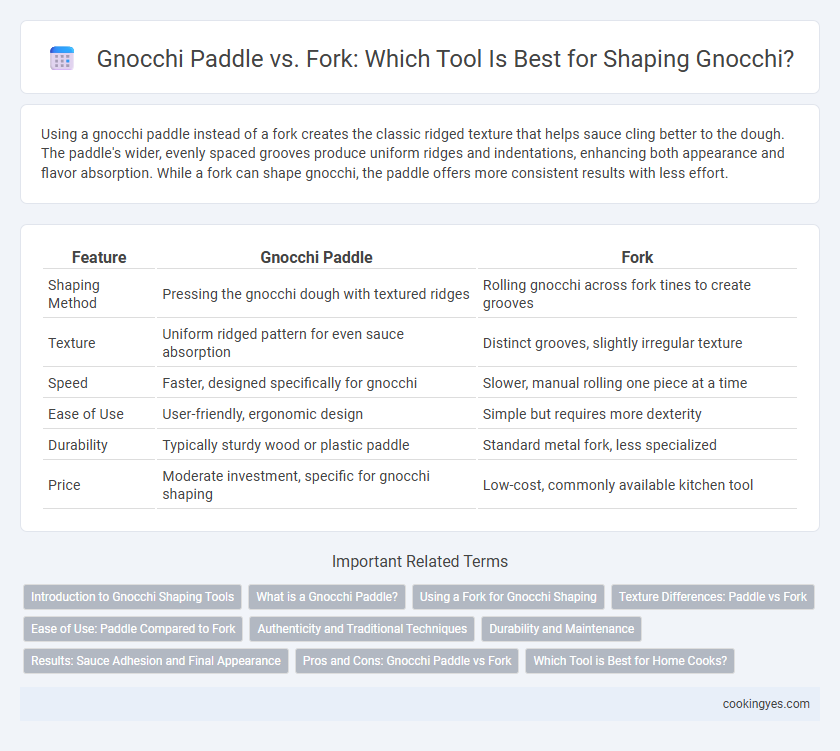Using a gnocchi paddle instead of a fork creates the classic ridged texture that helps sauce cling better to the dough. The paddle's wider, evenly spaced grooves produce uniform ridges and indentations, enhancing both appearance and flavor absorption. While a fork can shape gnocchi, the paddle offers more consistent results with less effort.
Table of Comparison
| Feature | Gnocchi Paddle | Fork |
|---|---|---|
| Shaping Method | Pressing the gnocchi dough with textured ridges | Rolling gnocchi across fork tines to create grooves |
| Texture | Uniform ridged pattern for even sauce absorption | Distinct grooves, slightly irregular texture |
| Speed | Faster, designed specifically for gnocchi | Slower, manual rolling one piece at a time |
| Ease of Use | User-friendly, ergonomic design | Simple but requires more dexterity |
| Durability | Typically sturdy wood or plastic paddle | Standard metal fork, less specialized |
| Price | Moderate investment, specific for gnocchi shaping | Low-cost, commonly available kitchen tool |
Introduction to Gnocchi Shaping Tools
The gnocchi paddle, traditionally made from wood, features ridged grooves designed specifically to create the characteristic grooves on gnocchi, enhancing their texture and ability to hold sauce. In contrast, a fork provides a simpler, readily available tool for shaping but produces less uniform ridges and a smoother finish. Selecting the right tool impacts the final dish's texture and sauce adherence, making the gnocchi paddle a preferred option for authentic Italian preparation.
What is a Gnocchi Paddle?
A gnocchi paddle, also known as a gnocchi board, is a small wooden or plastic tool featuring ridged grooves designed to shape and texture gnocchi dough. This paddle creates characteristic ridges on each gnoccho, which help sauce adhere better compared to the smoother surface produced by a fork. Using a gnocchi paddle streamlines the shaping process, ensuring uniform size and consistent texture for optimal cooking and presentation.
Using a Fork for Gnocchi Shaping
Using a fork for gnocchi shaping creates delicate ridges that help the sauce adhere better, enhancing flavor and texture. The tines of the fork gently press and elongate each dough piece, resulting in a uniform shape with pronounced grooves. This traditional technique is preferred for its simplicity and the distinct surface texture it imparts to potato gnocchi.
Texture Differences: Paddle vs Fork
Using a gnocchi paddle creates ridges that are broader and more uniform, providing a slightly crispier exterior when cooked due to increased surface area. A fork produces finer, more delicate grooves which lead to a softer texture and better sauce adherence. Texture differences from paddle versus fork shaping impact the overall mouthfeel and sauce retention of the gnocchi.
Ease of Use: Paddle Compared to Fork
Using a gnocchi paddle for shaping offers greater ease compared to a fork due to its ergonomic design and uniform grooves that create consistent ridges efficiently. The paddle's larger surface area allows for faster shaping of multiple gnocchi pieces without the repetitive motion required by a fork. This reduces hand fatigue and ensures evenly textured gnocchi that hold sauce better.
Authenticity and Traditional Techniques
Using a gnocchi paddle instead of a fork preserves the authenticity and traditional techniques of Italian gnocchi making, creating precise ridges that hold sauce better. The paddle's textured surface expertly shapes the dough, resulting in the classic light, fluffy texture cherished in Italian cuisine. Employing this traditional tool ensures each gnocchi piece maintains its heritage and optimal flavor absorption.
Durability and Maintenance
A gnocchi paddle, typically made from wood or durable plastic, offers superior durability compared to a fork, which can bend or lose its shape over time. The paddle's smooth surface simplifies maintenance by preventing dough from sticking, making it easier to clean than the tines of a fork. This durability and ease of upkeep make the gnocchi paddle a preferred tool for consistent shaping and longevity in the kitchen.
Results: Sauce Adhesion and Final Appearance
Using a gnocchi paddle creates deep, uniform ridges that enhance sauce adhesion, resulting in a richer flavor profile with every bite. In contrast, shaping gnocchi with a fork produces finer, less pronounced grooves, which may cause sauce to slide off more easily and yield a smoother, less textured appearance. The paddle's distinctive pattern not only improves the visual appeal by adding defined texture but also maximizes the sauce's grip for an authentic Italian experience.
Pros and Cons: Gnocchi Paddle vs Fork
Using a gnocchi paddle creates consistent ridges that help sauces cling better, enhancing flavor absorption, but it requires specialized equipment and can be less versatile. A fork offers easy accessibility and multifunctionality, allowing delicate shaping and ridges formation, yet it may produce less uniform ridges and slower shaping speed. Choosing between a gnocchi paddle and a fork depends on the desired texture precision, ease of use, and available kitchen tools.
Which Tool is Best for Home Cooks?
A gnocchi paddle is best for home cooks seeking consistent ridges that hold sauce well, thanks to its wooden grooves designed specifically for shaping dough. A fork works as a versatile alternative, allowing gentle pressing and shaping, but may produce less uniform ridges. For beginners, a gnocchi paddle offers ease and efficiency in achieving traditional texture and appearance.
Gnocchi paddle vs fork for shaping Infographic

 cookingyes.com
cookingyes.com